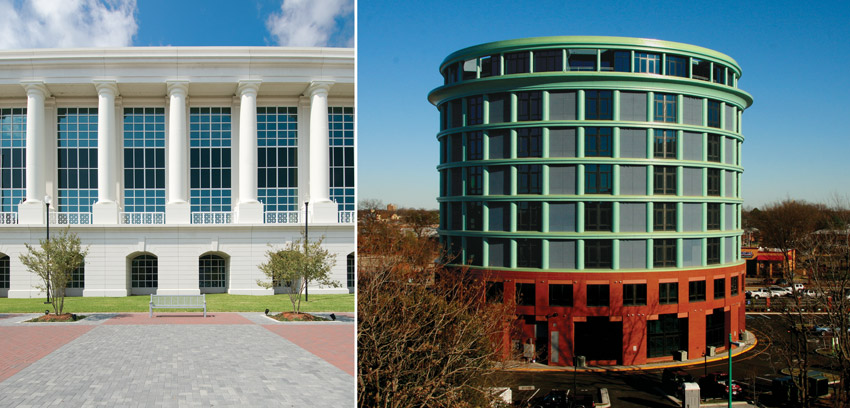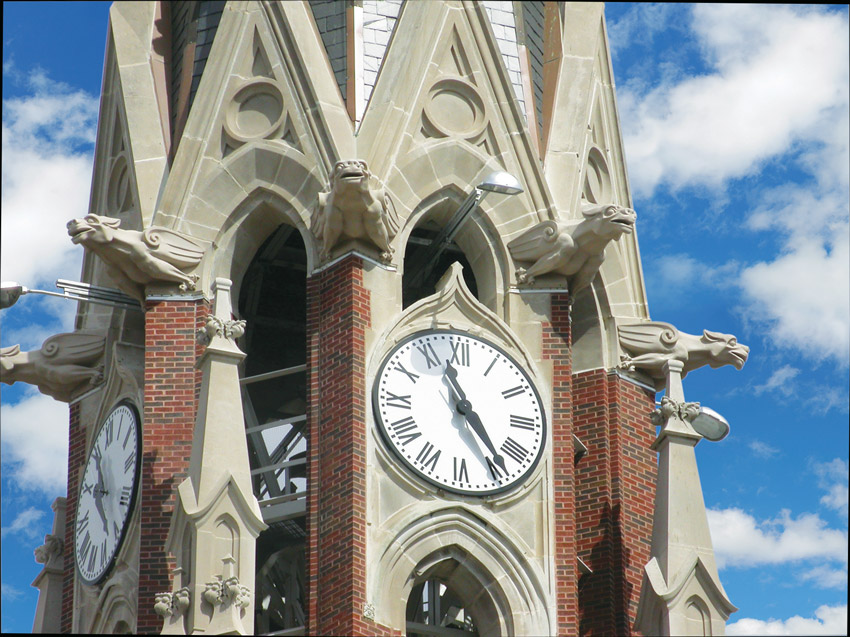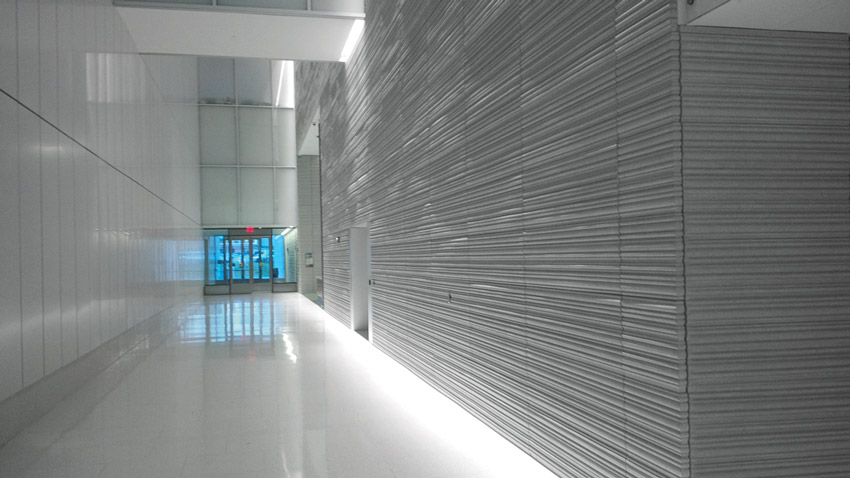Architectural Castings for Walls and Ceilings
Other appealing characteristics of GFRC include its complete design flexibility. It can be cast into virtually any shape or compound curve and has even been used to create ornamental figures, gargoyles, etc. Since they are custom fabricated, they can be engineered to reduce installation time and the associated labor costs. Finally, the concrete base of the material means that it is very low maintenance with durability enhanced by the addition of glass fibers.
GFRC castings are used for a wide range of component parts and elements of building facades and interiors. It is worth noting, though, that traditional building materials often require multiple, individual parts to achieve a desired outcome. By contrast, GFRC can be cast in larger panels that incorporate the look of all of those smaller parts, thus offering “part consolidation.” This aspect minimizes the actual number of pieces sent to the job site and reduces site labor accordingly.

GFRC can produce decorative columns, such as the traditional ones shown on the left and the paint-grade contemporary ones shown on the right.
All of these attributes make GFRC very appealing for building facades by providing 21st century solutions for things like cornices, friezes, pediments, and even cladding such as cast wall panels or rainscreens. For facades that seek decorative columns, those too can be made with GFRC in exactly the style, proportion, and size needed. They can also be cast for architectural details such as finials, panels, and cornices. This concept can be carried a step further with statue-like figures being cast for outdoor use at entries, along rooflines, or in landscaped areas. Of course, while all of these uses make sense for new construction, they can also be a major benefit to historic restoration projects where there is a need to match existing concrete or stone items on a facade in an accurate but cost-effective manner. Overall, GFRC provides the design flexibility and performance characteristics needed for many different types for building project conditions.
Glass Fiber-Reinforced Polyester Resin (FRP)
FRP is used for a lot of different purposes from recreational equipment like boats to building products such as floor gratings and wall panels. It is also a great material to use for architectural castings where lightweight, economical, and impact-resistant factors come into play. As such, it is a common choice for applications requiring weather resistance and durability for exteriors.
Glass fiber-reinforced polyester resin (FRP) is a composite consisting of gel coat, polyester resin, and glass fibers. Even though it contains polyester, it can be formulated to meet fire-performance requirements limiting the flame spread index to 25 or less per ASTM E84.
FRP architectural castings are specifically intended for exterior use and bring a number of compelling characteristics. Like the other materials we have looked at, it offers great design flexibility and can be cast into virtually any shape or compound curve. It is lighter in weight than concrete-based castings, coming in closer to gypsum-based castings at around only 2–3+ pounds per square foot depending on the shape and reinforcement details. This lighter weight and customizing ability help make it very easy to install using some conventional anchoring systems. Once in place, the durable and proven track record of FRP makes it very low maintenance. It is known for retaining its shape and beauty over time in a full range of weather conditions.

Glass fiber-reinforced polyester resin (FRP) is used on exteriors to create a variety of details, such as the gargoyles shown here.
The surface finish of FRP can be supplied in paint grade for field finishing or prefinished in the factory. In addition to smooth surface appearances, it can also be textured and painted to simulate stone, wood, or steel. That makes it a very versatile choice since it can end up in virtually any color, look like many different types of materials, and be a key component of any type of exterior design, whether traditional or contemporary.
Some of the typical uses of FRP architectural castings include facade elements such as cornices, panels, rainscreens, and decorative elements. They have also been used for specialty items like decorative columns, domes, and cupolas. Similarly, they have been formed as features such as planters, fountains, and even signage for buildings. In all, they offer a very versatile option that is ripe for imaginative use.
Cast Stone/Interior Molded Stone
For interior detailing, there is an additional option beyond GRG and GFRC. In some cases, particularly where a stone appearance is being sought, cast stone architectural castings are an economical and flexible alternative. They are ideally suited for interior castings that replicate the look of natural stone but with the ability to be cast into virtually any shape.
Cast stone is an interior molded stone (IMS) composite consisting of alpha gypsum cement, pigment, aggregate, water, and polymers. Since it is a gypsum-based product, it readily achieves Class A fire performance per ASTM E84, meaning it is suitable for large and small areas for interior walls and ceilings in commercial and institutional buildings. Since it can be cast into any shape or compound curve, it offers a great deal of design flexibility with a virtually unlimited range of custom casting shapes and sizes being possible. Further, since cast stone typically weighs only 2–5+ pounds per square foot depending on the shape and the reinforcement used, it can be readily attached to conventional wall and ceiling systems without any special construction needed.

Cast stone can be formed into decorative features or fashioned to create distinctive full-height wall panels as shown here.
The finished surface of cast stone is available in standard colors ranging from natural greys, tans, creams, and white as well as some greens and blues. It can also be cast in custom colors as may be desired. Cast stone is typically sealed with a clear satin coating for a durable, easy-to-clean finish. Since it is inherently durable to begin with, based on its material makeup, it is a long-lasting and very low-maintenance addition to interior designs.
Based on all of these attributes, cast stone is commonly used for a variety of interior treatments. It works very well as a cladding material for interior retail facades. For featured areas, cast stone can be made to form pediments, cornices, door surrounds, and trim, either as individual castings or integrated directly into larger wall and flat panels. It can also be used to form coverings over steel columns to provide the look of stone columns without the expense or the weight. The same is true with demising piers or other items that would benefit from a different appearance. For some specific details, cast stone can also be considered for things like fireplace surrounds and even signage.
Overall, if there is a need or a desire for a stone appearance for interiors, cast stone castings may provide the needed look with less weight, more control, and more cost efficiency.









